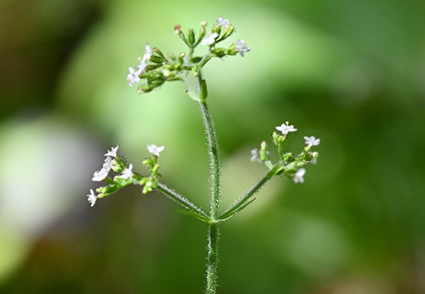Abstract
The species delimitation of Triplostegia has been controversy and traditionally includes two species: T. glandulifera and T. grandiflora. These two taxa differs in some morphological characters on leaves, size of corollas, and achene involucel apex. A recent study proposed to merge these two species into a single taxon, T. glandulifera, while the phylogenetic and morphological evidence suggests that this genus consists of three distinct species, including an undescribed species that is distributed in the Hengduan Mountains Region and east Himalaya. Following the phylogenetic and morphological thesis, the authors describe and illustrate this new species: Triplostegia alpina. This taxon is characterized by a brown main taproot with fine roots and one to three more slender white glabrous lateral taproots, petiolate and serrated leaves, corollas 1.1–2.2 mm, achene involucel apex in purple and slightly hooked, which are distinctive from its two congeners. The study highlight the diagnostic role of taproot, leaf, corolla, and achene involucel in delimiting Triplostegia species.
References
- Airy Shaw, H.K. (1965) Diagnoses of new families, new names, etc., for the seventh edition of Willis's 'Dictionary'. Kew Bulletin 18: 249–273. https://doi.org/10.2307/4109246
- Backlund, A. & Nilsson, S. (1997) Pollen morphology and the systematic position of Triplostegia (Dipsacales). Taxon 46: 21–31. https://doi.org/10.2307/1224288
- Batsch, A.J.G.C. (1802) Tabula affinatum regni vegetabilis. Vinariae, Landes-Industrie-Comptoir, 312 pp.
- Fu, Q.L., Mo, Z.Q., Xiang, X.G., Milne, R.I., Jacquemyn, H., Burgess, K.S., Sun, Y.N., Yan, H., Qiu, L., Yang, B.Y. & Tan, S.L. (2023) Plastome phylogenomics and morphological traits analyses provide new insights into the phylogenetic position, species delimitation and speciation of Triplostegia (Caprifoliaceae). BMC Plant Biology 23: 645. https://doi.org/10.1186/s12870-023-04663-4
- Hong, D.Y., Ma, L.M. & Barrie, F.R. (2011) Dipsacaceae. In: Wu, Z.Y., Hong, D.Y. & Raven, P.H. (Eds.) Flora of China. Vol. 19. Science Press and Missouri Botanical Garden Press, Beijing and St. Louis, pp. 654–660.
- IUCN. (2022) Guidelines for using the IUCN Red List categories and criteria. Version 15.1. Prepared by the Standards and Petitions Committee. Available from: https://www.iucnredlist.org/resources/redlistguidelines (accessed 15 January 2024).
- Jacobs, B., Geuten, K., Pyck, N., Huysmans, S., Jansen, S. & Smets, E. (2011) Unraveling the Phylogeny of Heptacodium and Zabelia (Caprifoliaceae): An Interdisciplinary Approach. Systematic Botany 36: 231–252. https://doi.org/10.1600/036364411X553306
- Jussieu, A.L. de. (1789) Genera plantarum secundum ordines naturales disposita. Parisiis (Paris), Apud Viduam Herissant, 498 pp.
- Niu, Y.T., Jabbour, F., Barrett, R.L., Ye, J.F., Zhang, Z.Z., Lu, K.Q., Lu, L.M. & Chen, Z.D. (2018) Combining complete chloroplast genome sequences with target loci data and morphology to resolve species limits in Triplostegia (Caprifoliaceae). Molecular Phylogenetics and Evolution 129: 15–26. https://doi.org/10.1016/j.ympev.2018.07.013
- Niu, Y.T., Barrett, R.L., Zhang, Z.Z., Lu, L.M. & Chen, Z.D. (2019) Taxonomic revision of Triplostegia (Caprifoliaceae: Dipsacales). Phytotaxa 392: 19–32. https://doi.org/10.11646/phytotaxa.392.1.2
- Park, S., Jun, M., Park, S. & Park, S. (2021) Lineage-Specific Variation in IR Boundary Shift Events, Inversions, and Substitution Rates among Caprifoliaceae s.l. (Dipsacales) Plastomes. International Journal of Molecular Sciences 22: 10485. https://doi.org/10.3390/ijms221910485
- Perrino, E.V., Mahmoud, Z.N.A., Valerio, F., Tomaselli, V., Wagensommer, R.P. & Trani, A. (2023) Synecology of Lagoecia cuminoides L. in Italy and evaluation of functional compounds presence in its water or hydroalcoholic extracts. Scientific Reports 13: 20906. https://doi.org/10.1038/s41598-023-48065-w
- Perrino, E.V., Silletti, G.N., Erben, M. & Wagensommer, R.P. (2018) Viola cassinensis subsp. lucana (Violaceae), a new subspecies from the Lucanian Apennine, southern Italy. Phyton (Horn, Austria) 58 (2): 109–115. https://doi.org/10.12905/0380.phyton58(2)-2018-0109
- Pyck, N. & Smets, E. (2004) On the systematic position of Triplostegia (Dipsacales): A combined molecular and morphological approach. Belgian Journal of Botany 137: 125–139.
- Sağiroğlu, M. & Eker, I. (2021) Gladiolus aladagensis (Iridaceae), a new species from Turkey. Phytotaxa 478 (1): 151–161. https://doi.org/10.11646/phytotaxa.478.1.11
- Thiers, B. (2023) Index Herbariorum: A global directory of public herbaria and associated staff. New York Botanical Garden’s Virtual Herbarium. Available from: http://sweetgum.nybg.org/science/ih/ (accessed: 15 January 2024).
- Wang, H.X., Liu, H., Moore, M.J., Landrein, S., Liu, B., Zhu, Z.X. & Wang, H.F. (2020) Plastid phylogenomic insights into the evolution of the Caprifoliaceae s.l. (Dipsacales). Molecular Phylogenetics and Evolution 142: 106641. https://doi.org/10.1111/jse.12526
- Xiang, C.L., Dong, H.J., Landrein, S., Zhao, F., Yu, W.B., Soltis, D.E., Soltis, P.S., Backlund, A., Wang, H.F., Li, D.Z. & Peng, H. (2020) Revisiting the phylogeny of Dipsacales: New insights from phylogenomic analyses of complete plastomic sequences. Journal of Systematics and Evolution 58: 103–117. https://doi.org/10.1016/S1055-7903(02)00303-2
- Zhang, W.H., Chen, Z.D., Li, J.H., Chen, H.B. & Tang, Y.C. (2003) Phylogeny of the Dipsacales s.l. based on chloroplast trnL-F and ndhF sequences. Molecular Phylogenetics and Evolution 26: 176–189. https://doi.org/10.1016/j.ympev.2019.106641


